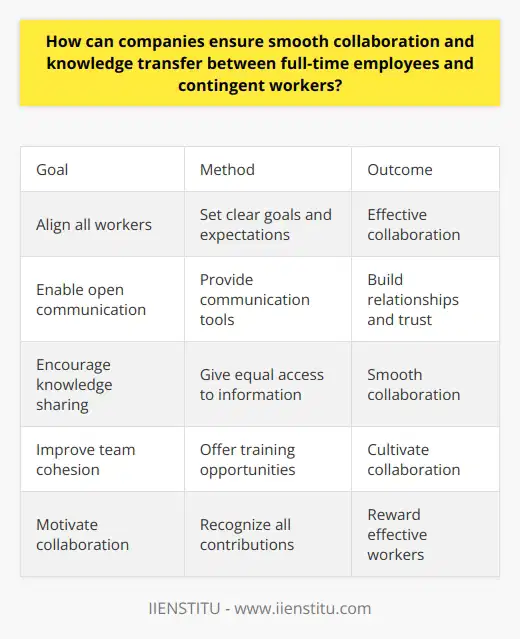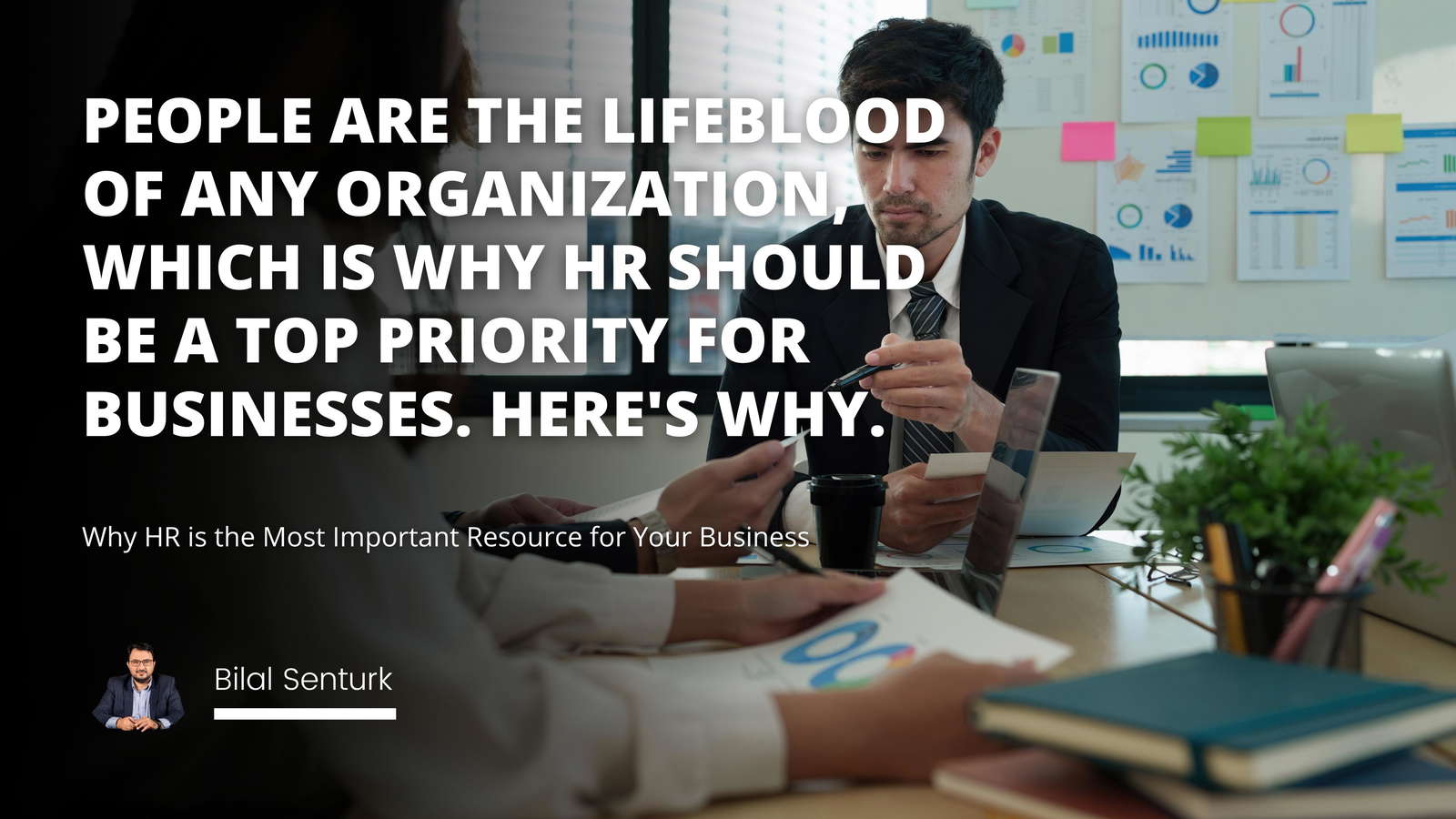
Embracing the Contingent Workforce: A Journey Towards Organizational Success
Utilizing the Benefits
Leveraging Technology
Ensuring Success
I still remember sitting in my office one late evening, staring at a project timeline that seemed impossible to meet with our current team. We had just landed a major client, but our permanent staff was already stretched thin. That's when my colleague suggested, "Why not bring in some contingent workers?" At first, I was skeptical. But little did I know, this would be the turning point that not only saved the project but also reshaped our approach to talent management.
Organizations today are navigating an increasingly complex landscape when it comes to talent acquisition and management. The rapid pace of change in markets and technology means that traditional hiring practices often fall short. This is where the concept of a contingent workforce comes into play—a strategy that can provide the flexibility and specialized skills that organizations desperately need.
Understanding the Contingent Workforce
So, what exactly is a contingent workforce? In essence, it's a pool of non-permanent employees who are hired on an as-needed basis. These workers might be freelancers, consultants, or contractors engaged for short-term projects or specific expertise. They're not part of the core permanent staff, but they play a crucial role in helping organizations adapt and thrive in a dynamic environment.
The Rise of Non-Permanent Employees
In the past decade, there's been a significant shift toward this model. According to Smith's "The Flexible Workplace" (2018), companies that embrace a mix of permanent and contingent workers are better positioned to respond to market fluctuations. This hybrid approach allows businesses to scale up or down without the long-term commitment and overhead associated with permanent hires.
The Benefits of a Contingent Workforce
Reflecting on my own experience, the benefits became clear almost immediately. We were able to bring on a team of specialists who hit the ground running. Here's why many organizations are turning to contingent workers:
1- Cost-Effectiveness: Hiring contingent workers can be more budget-friendly. You pay for the expertise when you need it, without the ongoing costs of salaries, benefits, and pensions.
2- Specialized Skills: These workers often bring in niche skills or knowledge that your current team may lack. It’s like having a toolbox where you can pick the exact tool needed for a specific job.
Maximizing Benefits requires the integration of both permanent and contingent workforces, as they offer unique opportunities and perspectives.
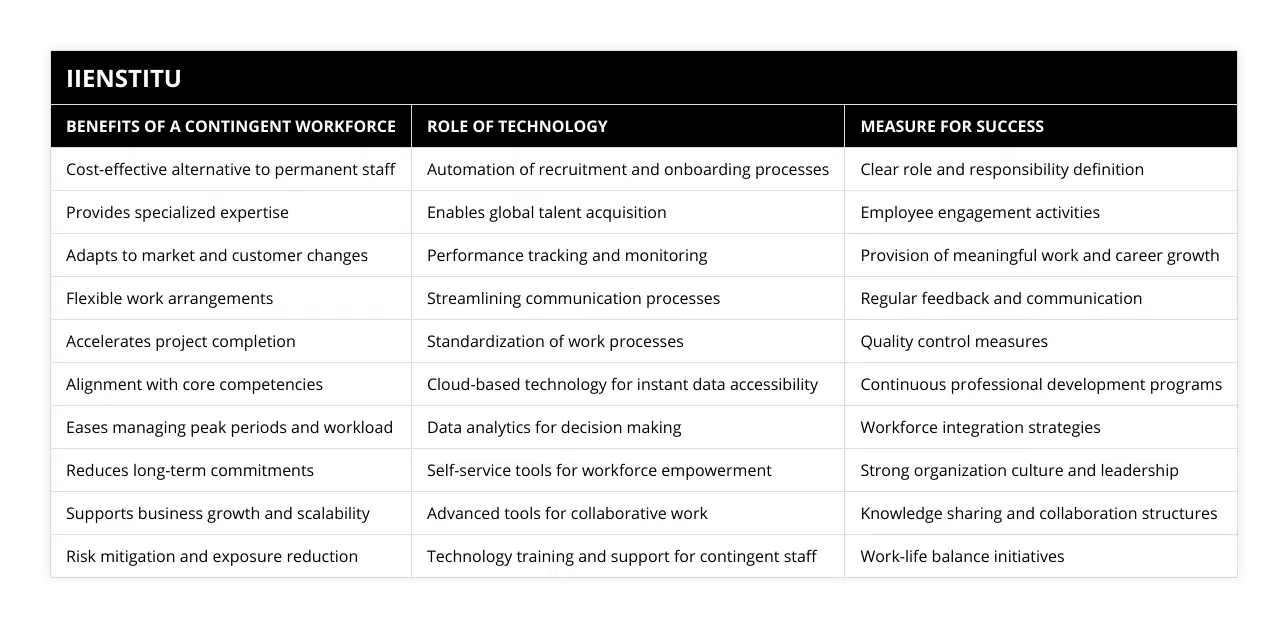
3- Flexibility and Adaptability: In times of uncertainty, having a flexible workforce allows you to adjust quickly. Whether it's scaling up for a big project or scaling down during slower periods, contingent workers make it easier.
4- Faster Project Completion: With specialists on board, projects can often be completed more efficiently. They bring experience and expertise that can accelerate timelines.
5- Fresh Perspectives: Sometimes, an outsider's view can shed light on blind spots. Contingent workers can offer new ideas and challenge existing processes.
These advantages are not just theoretical. In our case, the contingent team helped us deliver the project ahead of schedule, impressing the client and securing future contracts.
Maximizing the Benefits: A Strategic Approach
However, simply hiring contingent workers isn't a magic bullet. To truly reap the benefits, organizations need a strategic approach.
Planning and Management are Key
When we first ventured into using a contingent workforce, we quickly realized that planning was essential. As Johnson and Lee point out in "Strategic Talent Management" (2020), without a clear plan, the integration of contingent workers can lead to confusion and inefficiency.
Here are some steps we found invaluable:
Define Clear Objectives: What do you hope to achieve by bringing in contingent workers? Is it to fill a skill gap, handle overflow work, or speed up a project?
Establish a Timeline: Have a clear start and end date. This helps in setting expectations and ensuring that project milestones are met.
Transparent Recruitment Process: Just like hiring permanent staff, vetting contingent workers is crucial. We developed a streamlined process to assess candidates' qualifications and fit.
Aligning with Core Competencies
It's tempting to hire someone who looks great on paper, but alignment with your organization's core competencies is vital. We made sure that each contingent worker understood our mission and values. This alignment not only ensured quality work but also helped them integrate more smoothly with our permanent team.
Leveraging Technology for Seamless Integration
One of the game-changers for us was leveraging technology. In today's digital age, technology isn't just helpful—it's essential.
Automating Recruitment and Onboarding
We utilized an applicant tracking system (ATS) to manage applications and resumes efficiently. This automation saved us countless hours. In "Digital Workforce Management" by Ellen Rogers (2019), it's noted that companies using ATS experience a 30% reduction in time-to-hire.
Global Talent Pool
Technology breaks down geographical barriers. With video conferencing tools and collaboration platforms, we were able to tap into talent from around the world. This global reach meant we could find the perfect match for our needs, regardless of location.
Monitoring Performance with Tech Tools
To get the most out of our contingent workers, we used project management software to assign tasks, set deadlines, and track progress. Tools like Trello and Asana became staples in our daily operations. They provided transparency and kept everyone aligned.
Ensuring Success Through Engagement and Communication
One lesson we learned the hard way was that contingent workers need just as much clarity and engagement as permanent staff.
Setting Clear Expectations
From the outset, we made sure to communicate roles, responsibilities, and expectations. This clarity helped prevent misunderstandings and kept projects on track.
Fostering Inclusion
We included contingent workers in team meetings and communications. By making them feel part of the team, we boosted morale and commitment. In "The Human Side of Temporary Work" (Clark & Nelson, 2021), the authors emphasize that inclusion leads to higher productivity among non-permanent staff.
Providing Feedback and Growth Opportunities
Just because someone is temporary doesn't mean they don't appreciate feedback. We provided regular updates on performance and even offered opportunities for professional development. This approach not only enhanced their work but also built loyalty and encouraged them to work with us on future projects.
Integrating Contingent and Permanent Workforces
Maximizing benefits truly comes from integrating both permanent and contingent workers. Each group brings unique strengths and perspectives.
Creating a Collaborative Environment
We encouraged collaboration between all team members. This meant organizing joint brainstorming sessions, team-building activities, and open forums for idea exchange.
Leveraging Diverse Perspectives
Contingent workers often bring experiences from various industries and companies. We tapped into this diversity to drive innovation within our projects.
Overcoming Challenges
Of course, it's not all smooth sailing. There are challenges to incorporating a contingent workforce.
Legal and Compliance Issues
Navigating the legal aspects can be tricky. We consulted with our legal team to ensure compliance with labor laws and regulations. According to "Employment Law for Business" by Bennett-Alexander and Hartman (2017), misclassification of workers can lead to significant penalties.
Cultural Differences
Especially when working with global talent, cultural differences can impact communication and expectations. We invested time in cultural competency training for our managers to bridge these gaps.
The Role of Leadership
Effective leadership is crucial in this endeavor.
Leading by Example
Our management team made a point to embrace the contingent workforce model fully. By demonstrating commitment, they encouraged others to do the same.
Open Communication Channels
Leaders maintained open lines of communication, addressing concerns promptly and ensuring that everyone felt heard.
Personal Reflections on the Journey
Looking back, integrating a contingent workforce was one of the best decisions we made. It wasn't just about meeting project deadlines; it was about evolving as an organization.
I recall one contingent worker, Maria, who brought in an innovative approach to data analysis that we hadn't considered before. Her contributions didn't just benefit the project at hand but influenced how our permanent team approached future projects.
Incorporating Best Practices
For organizations considering this path, here are some best practices we found helpful:
Develop Clear Contracts: Define terms, scope of work, and expectations in writing.
Invest in Onboarding: Even though they are temporary, a proper onboarding process helps contingent workers integrate faster.
Protect Intellectual Property: Ensure agreements include clauses to safeguard your company's IP.
Provide Necessary Resources: Equip them with the tools and access they need to perform efficiently.
Conclusion: A New Era of Workforce Management
Integrating a contingent workforce isn't just a trend; it's a strategic move that aligns with the modern world's demands. By leveraging technology, strategically planning, and fostering an inclusive environment, organizations can unlock new levels of efficiency and innovation.
In the words of Michael E. Porter's "Competitive Advantage" (1985), staying ahead requires not just reacting to changes but anticipating and shaping them. Embracing a contingent workforce is one way organizations can do just that.
A Note on Reassignment and Flexibility
Interestingly, the principles that apply to managing a contingent workforce can also be valuable when employees seek changes within the organization. For those looking to make a shift, understanding the company's approach to flexibility can be helpful. If you're considering this, you might find it useful to consult reassignment request letter tips and information to navigate the process smoothly.
References
Bennett-Alexander, D., & Hartman, L. (2017). Employment Law for Business. McGraw-Hill Education.
Clark, P., & Nelson, T. (2021). The Human Side of Temporary Work. Oxford University Press.
Johnson, M., & Lee, K. (2020). Strategic Talent Management. Pearson.
Porter, M. E. (1985). Competitive Advantage: Creating and Sustaining Superior Performance. Free Press.
Rogers, E. (2019). Digital Workforce Management. TechPress.
Smith, A. (2018). The Flexible Workplace: A New Approach to Workforce Planning. Business Insights Publishing.
Embracing the contingent workforce model transformed our organization's approach to talent management. It's not without its challenges, but with careful planning and an open mind, the rewards are substantial. Whether you're a small startup or a multinational corporation, considering this strategy might just be the key to staying competitive in an ever-changing world.
Frequently Asked Questions
What strategies can be implemented to maximize benefits from integrating a contingent workforce?
Contingent workers are not full-time employees but are on call, usually with flexible hours, to perform specific activities in support of an organization's operations. Using torganization'srker can benefit a company, but organizations must implement strategic and effective management practices to maximize the benefits.
One of the critical strategies for successfully leveraging a contingent workforce is the implementation of effective recruitment procedures. Businesses should evaluate potential workers carefully and select those best suited to their organization's objectives and requiremeorganization'sudes, considering factors such as skill level, experience, and availability. Additionally, organizations should ensure that workers have the necessary training and qualifications to perform their tasks.
Once recruited, organizations need to ensure that their contingent workers are appropriately managed. To this end, businesses should set clear expectations, goals, and objectives for their workers and provide ongoing support, including feedback, for the duration of their contract. This will motivate the workers to meet deadlines and standards and ensure that they are continually learning and growing. Additionally, organizations should provide clear employee policies and communication channels to ensure minimal disruption.
Finally, businesses should track their contingent workforce’s performance to determine their success and ROI. This could involve surveying workers regularly to measure employee satisfaction and productivity, accessing insights regarding activities completed, or using performance metrics to measure efficiency. Organizations should also look to discover any gaps to identify areas of improvement and make improvements as necessary.
When implemented effectively, a contingent workforce can drive success and help improve an organization’s bottom line. By following the organization's workforce outlined above, businesses can make sure they are making the most of their investments and reaping the full benefits of each contributing worker.
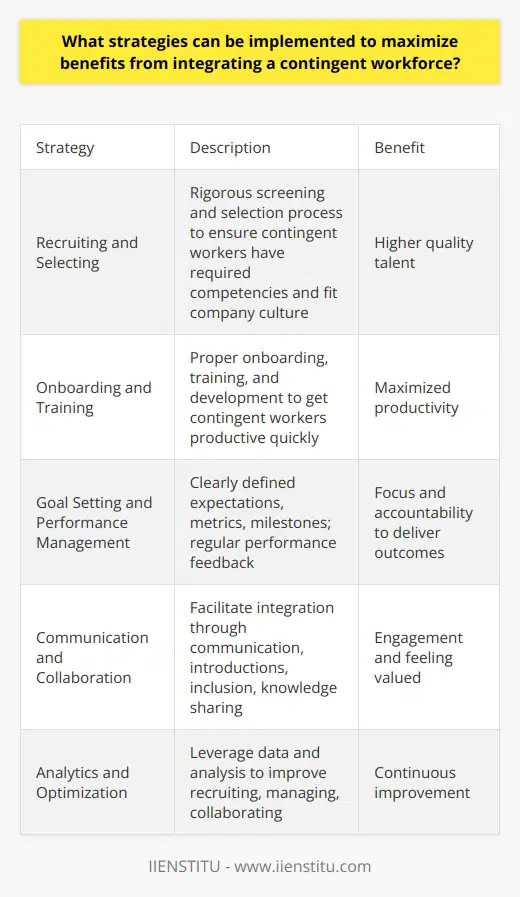
What challenges can be expected when integrating a contingent workforce?
Integrating contingent workers into the workforce can be a beneficial endeavor for many organizations. It provides a more flexible approach to workforce management, enabling a company to scale up or down their staff numbers as required rapidly. However, integration also comes with its suite of challenges. Below are some key areas to consider when integrating a contingent workforce.
Recruitment & Onboarding: It can be challenging to ensure that the recruitment process for contingent workers is fair and consistent. Additionally, contingency workers can be unaware of the onboarding process due to their limited contact with the organization. This can drastically affect engagement levels among the workforce and lead to a lack of clarity when unforeseen challenges arise.
Training & Development: As mentioned, contingent workers may not have much contact with the organization. This can make it challenging to provide the necessary training and development. Therefore, it is essential to ensure that contingent workers have adequate training and development to understand their roles and responsibilities and help them reach their fullest potential.
Communication & Collaboration: Clear communication and collaboration between the different teams within an organization are essential. However, minimal contact makes contingent workers feel disconnected from the central section. Therefore, organizations must find ways to facilitate communication and collaboration between the contingent workers and the rest of the units.
Fiscal & Legal Compliance: Contingent workers are often employed in different ways than permanent employees, so it is necessary to ensure they meet the required fiscal and legal obligations. For example, various laws may require that the company provides a certain level of insurance for contingent workers. Therefore, ite diligence and research are essential to ensure all necessary fiscal and legal requirements are met.
In conclusion, several challenges can be expected when integrating a contingent workforce. However, when managed correctly, combining a contingent workforce can allow organizations to be more agile and flexible in meeting changing demands.
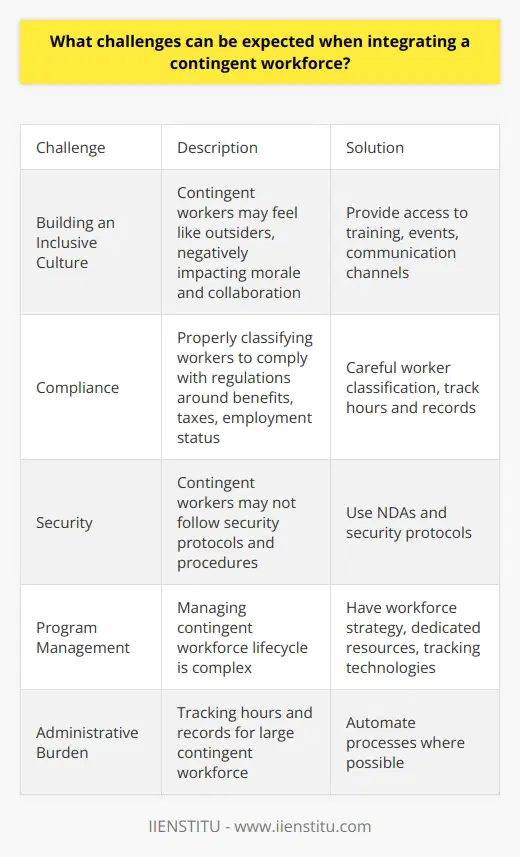
How can organizations ensure that the integration of a contingent workforce is successful?
Organizations have come to rely increasingly on contingent or irregular workforce populations to meet the demands of the global market in terms of cost efficiency and agility. Contingent workers are hired on a project-by-project basis and complete the tasks for which they are recruited independently of the traditional employer-employee relationship. Therefore, organizations must successfully integrate these contingent workers by following a few simple steps.
First, organizations should ensure that any contingent workers they recruit thoroughly understand what their role entails. This requires more than explaining their job duties – the organization should provide sufficient resources and training to help the contingent worker do their job well. It is also essential to give feedback and recognition of their work to encourage dedication and motivation.
Second, organizations should create an environment conducive to the successful integration of contingent workers. This includes ensuring that contingent workers are appropriately introduced, provided with the necessary resources, and integrated into the day-to-day functioning of the office. Organizations should also ensure that the lines of communication between permanent and contingent staff are kept open.
Third, organizations should develop policies designed to maximize a contingent workforce's benefits. These policies should specify the types of activities in which the contingent worker can engage, the levels of supervision required, and how the work of the contingent worker must be integrated with the rest of the organization.
Finally, organizations should monitor and measure the performance of the contingent workers to ensure that the integration is successful. This includes assessing the quality of their work, the efficiency with which they are completing tasks, and their ability to collaborate and communicate with permanent staff effectively.
When organizations meet these steps, they can reap the benefits of successfully integrating a contingent workforce, including reduced overhead costs and improved resource utilization. As such, organizations should take the necessary steps to ensure that the integration of a contingent workforce is thriving.

How can organizations effectively manage their contingent workforce to achieve optimal results?
Understanding Contingent Workforce
Organizations can manage their contingent workforce effectively to achieve optimal results through several strategies. To begin, they must understand the nature of contingent work. In essence, it comprises of non-permanent employees, freelancers, and contractors who render services on-demand.
Planning and Analysis
Proper planning is critical in the effective management of a contingent workforce. The organization should assess their labor needs meticulously. This analysis will determine the level of dependence on contingent labor to meet objectives. Furthermore, it guides decision-making on whether to increase, reduce, or maintain the current levels of contingent labor.
Fostering Clear Communication
Open communication channels are vital. Employers should always communicate expectations and feedback to contingent workers. Clear, consistent communication promotes understanding and engagement. This mutual understanding can lead to higher productivity, satisfaction, and loyalty among contingent workers.
Integrating Contingent and Regular Workforce
Integration of contingent and regular employees is essential. This strategy ensures every team member feels valued, fostering a sense of unity and inclusivity. Therefore, it is vital to include the contingent workforce in team-building activities, trainings, and meetings alongside regular employees.
Maximizing Technology
Incorporation of technology is crucial in managing a contingent workforce. Technological tools like workforce management systems can streamline processes, enhance efficiency, and improve transparency. These elements play a significant role in cultivating satisfaction and productivity in contingent workers.
Monitoring and Evaluation
Evaluation is an integral part of managing contingent workforce. Regular reviews help organizations measure the impacts of their strategies. Further, they facilitate timely adjustments to align the contingent labor pool with the organization's goals.
In conclusion, effectively managing a contingent workforce requires understanding the nature of their work, proper planning, fosters open communication, integrating them with regular staff, using technology, and regular reviews. When organizations commit to these steps, they can achieve optimal results from their contingent workforce.
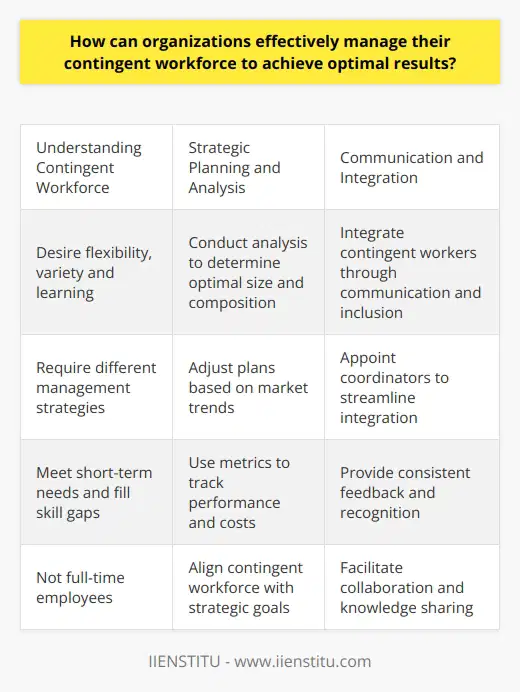
What measures can be taken to address potential challenges and risks associated with a contingent workforce?
Defining Contingent Workforce Strategy
The contingent workforce refers to a labor pool whose members are hired by an organization on an on-demand basis. This workforce structure poses potential risks and challenges that require strategic measures for effective management.
Risk Mitigation
A key to mitigating risks is to enforce stringent screening and hiring practices. This means doing background checks, verifying qualifications and ensuring workers meet the job requirements.
Workforce Integration
Effective integration of the contingent workforce is crucial. This involves clearly defining their roles and responsibilities and ensuring they understand the organization's objectives.
Legal Compliance
Adherence to legislative requirements is essential. The organization has to ensure it meets all legal obligations related to wages, benefits, and working conditions.
Workforce Management Technology
The introduction of workforce management technology helps in monitoring and managing a contingent workforce. This includes the use of advanced software for time and performance management.
Contract Clarity
Establishing clear contracts with contingent workers prevents misunderstandings about compensation, roles, and expectations. This builds a respectable, efficient and mutually beneficial relationship.
Training and Development
Inducting contingent workers through robust training programs equips them with necessary skills and knowledge. Investing in their continuous development fosters a sense of belonging and enhances their job performance.
Communication and Feedback
Ensuring effective communication channels are necessary. Regular feedback encourages continuous improvement and promotes a healthy work environment, decreasing the chances of conflict.
Overall, managing a contingent workforce involves proactive planning. Adopting thoughtful strategies for risk mitigation, compliance, integration, training and feedback can ensure a productive and effective contingent workforce. These measures contribute to successfully navigating the challenges and risks inherent in a contingent workforce model.
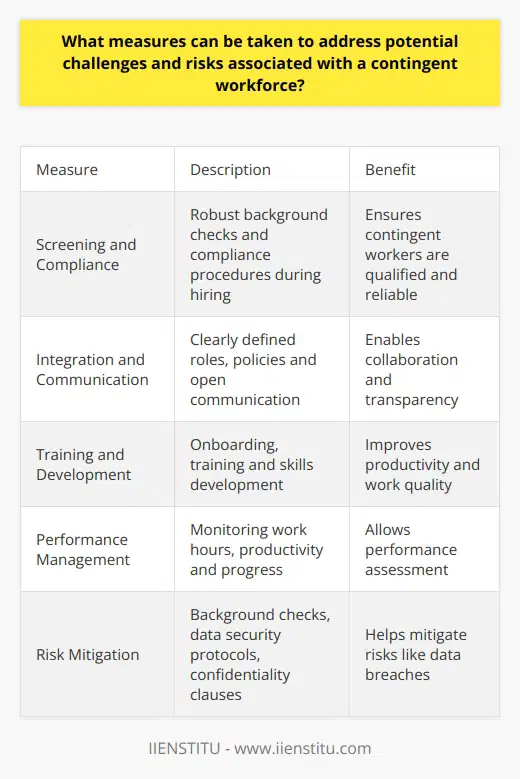
How can an organization's culture and communication strategies be adapted to better integrate and support contingent workers within the team environment?
Creating an Inclusive Organizational Culture
To support contingent workers within a team, organizations should promote an inclusive culture. This can be achieved by incorporating practices that value diversity, knowledge sharing, and respect for all forms of work arrangements. This approach can lower barriers and create openness towards contingent workers.
Innovative Communication Strategies
Effective communication strategies also play a crucial role. The organization should ensure clear, consistent, and timely communication to contingent workers regarding their roles, expectations, and how their work contributes to overall organizational goals. This promotes a sense of purpose and encourages loyalty.
Promoting Team Integration
To improve team integration, the organization can incorporate contingent workers into team meetings, decision-making processes, and social events whenever possible. Such approaches can foster relationships, encourage collaboration, and make contingent workers feel more part of the team.
Rewarding Achievements
Acknowledging and rewarding the accomplishments of contingent workers helps boost their morale and motivation. They feel valued and that their contributions matter.
Training and Development Opportunities
Offering contingent workers opportunities for training and professional growth improves their skills and productivity. It also shows the organization's investment in their success.
Humane and Fair Treatment
To fully integrate contingent workers, organizations need to treat them with humanity and fairness. This includes providing them with decent work conditions, competitive remuneration, and addressing their grievances. Fair treatment fosters equity and eliminates discrimination against contingent workers. This in turn promotes a healthy work environment where everyone feels accepted.
In conclusion, organizations can effectively integrate and support contingent workers by fostering an inclusive culture, implementing clear communication strategies, promoting team integration, rewarding achievements and providing adequate training opportunities whilst ensuring fair treatment. These adaptions will result not only in a more dynamic and diverse workforce, but also in a more resilient and innovative organization.
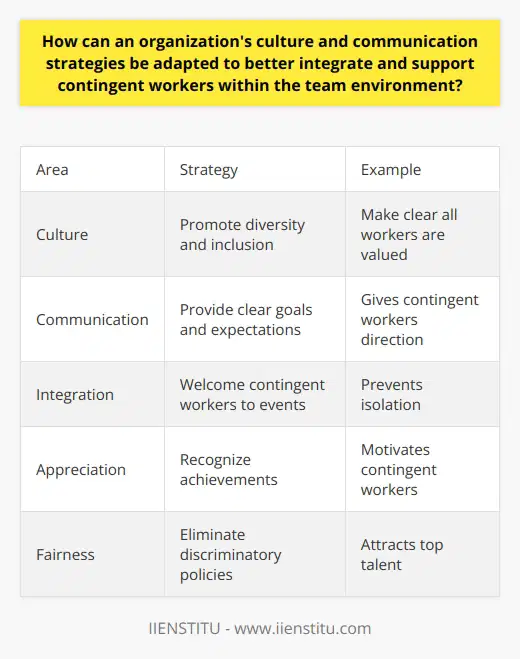
How should companies maximize the contingent worker?
Understanding Contingent Workers
To maximize the potential of contingent workers, companies should first understand the unique attributes of this demographic. Unlike full-time employees, contingent workers often choose their work based on flexibility and variety. Thus, companies should provide assignments that match these preferences, to attract and retain such workers.
Addressing Training Needs
Training is essential for contingent workers to align with the company’s operations and objectives. Structured training programs should be provided, ensuring these workers understand their roles clearly. However, companies must respect the inherent flexibility associated with contingent work by offering adaptable training solutions, like online modules.
Creating Collaborative Work Environment
A welcoming, inclusive environment encourages contingent workers to be more involved and productive. They should feel valued and part of the team. Regular meetings and social events can promote a sense of belonging and improve overall satisfaction.
Prioritizing Clear Communication
Clear communication is crucial to maximize contingent worker’s potential. Companies need to convey their expectations transparently and provide specific feedback on performance. Regular dialogues foster trust and mutual respect, inducing higher productivity.
Ensuring Legal Compliance
Companies should also ensure legal regulations are adhered to concerning contingent labor. Misclassification or non-compliance may lead to reputational damage and financial penalties. HR should be diligent in maintaining up-to-date knowledge of labor laws and worker rights to avoid legal complications.
Incorporating Useful Technology
Use of technology can facilitate recruitment and management of contingent workers. Companies can use digital platforms to communicate, assign tasks, and monitor performance. Efficient use of technology helps to streamline operations while preserving the flexibility preferred by contingent workers.
In conclusion, by recognizing the unique needs of contingent workers and addressing them, companies can maximize the potential of this dynamic workforce. This involves strategic planning, clear communication, cutting-edge technology and a firm commitment to legal compliance and fairness.
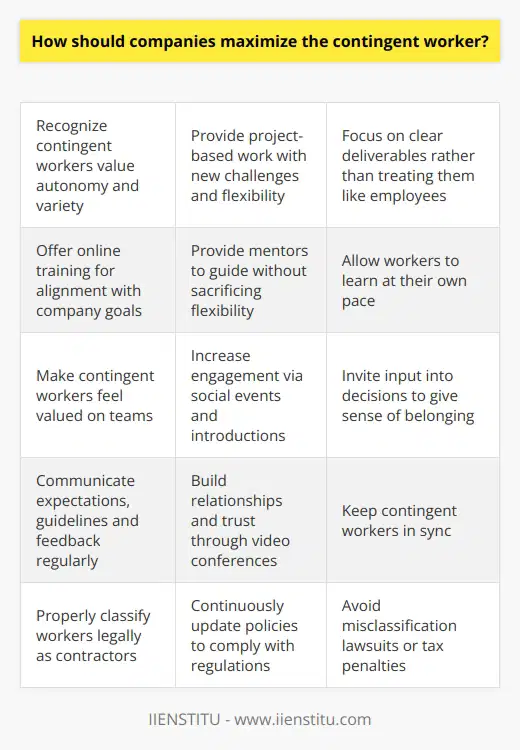
What can an organization do to best utilize and integrate contingent workers?
Ensuring Equal Treatment
To best utilize and integrate contingent workers, organizations need to ensure equal treatment. Agencies should offer similar benefits, such as training and advancement opportunities to contingent workers, like permanent employees.
Building Inclusive Culture
Moreover, integrating contingent workers into an organization's culture is crucial. Employers can cultivate an inclusive environment, fostering a sense of belonging for contingent workers. This approach can collaborate with the workers in team-building activities and social events.
Effective Communication
Effective communication channels can aid in integrating contingent workers. Regular meetings that include contingent staff foster an open dialogue. This interaction can provide opportunities for the workers to voice their ideas and concerns. Companies can include these workers in email correspondence and other forms of internal communication.
Providing Necessary Tools and Resources
Organizations should equip contingent workers with essential tools. Providing access to necessary resources like company databases, tools, and technology aids in their work efficiency. Giving them the right workplace equipment can enable them to carry out their tasks effectively.
Cross-Functional Collaboration
Organizations can foster cross-functional collaboration. Incorporating contingent workers into different projects and teams can enable them to contribute diversely. This strategy can maximize the unique skills and experiences these workers bring to the table.
Systematic Approach
Lastly, adopting a systematic approach to manage contingent workers' lifecycle can be beneficial. This approach involves recruitment, onboarding, talent development, and offboarding processes. A systematic handle of contingent workers can optimize their productivity and engagement.
In conclusion, to effectively utilize and integrate contingent workers, an organization needs to ensure equal treatment, foster an inclusive culture, streamline communication, provide necessary resources, encourage cross-functional collaboration, and adopt a systematic approach to their management.
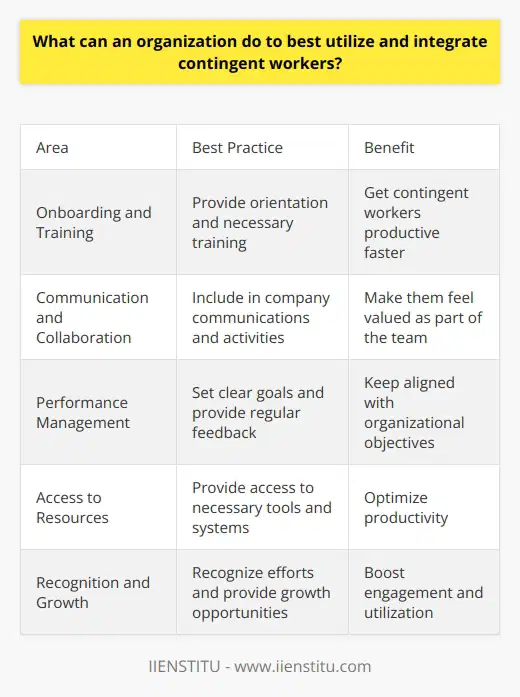
What are the benefits of a contingent workforce?
Ability to Adapt to Demand
A notable benefit of a contingent workforce is the capacity to adjust with fluctuating business demands. This workforce can extend or reduce based on the volume of work.
Cost Efficiency
Implementing a contingent workforce reduces operating costs. Businesses pay only for the work done, minimizing overheads related to full-time staffs' benefits and payroll taxes.
Access to Specialized Skills
Contingent workers often have specialized skills. Businesses can hire them for specific projects. This provides access to high-level expertise without long-term commitment.
Increased Productivity
Productivity levels can witness a boost with a contingent workforce. Focusing on their specialized tasks, these workers can deliver projects faster, driving results.
Workforce Diversity
A diverse workforce widens the range of ideas, experiences, and skills within a company. A contingent workforce can significantly contribute to this, offering varied perspectives and innovative solutions.
Risk Management
Contingent workers allow businesses to manage risks better. They help avoid long-term obligations, making staffing adjustments simpler in economic downturns.
In conclusion, a contingent workforce provides numerous benefits, including adaptability, cost efficiency, access to specialized skills, productivity, diversity, and risk management. Such a workforce model is beneficial to businesses seeking to thrive in fluctuating market scenarios.
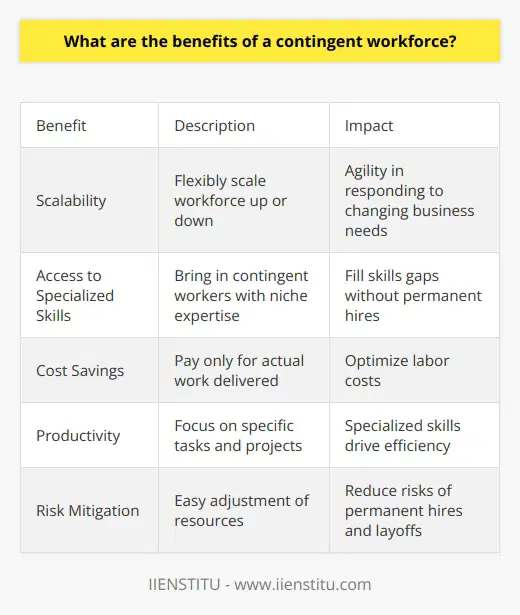
How can organizations create an inclusive environment for both full-time employees and contingent workers?
Promoting Diversity in the Work Environment
Organizations can enhance inclusivity by promoting diversity. This approach involves appreciating both full-time employees and contingent workers' skills and perspectives. They must eschew the one-size-fits-all mentality by treating each worker as an individual with unique ideas and contributions.
Nurturing a Sense of Belonging
Fostering an affinity among employees is crucial. All workers must feel their opinions matter, regardless of their employment status. Providing platforms for sharing ideas can encourage openness and foster a sense of belonging.
Improving Communication Channels
Communication is pivotal in creating inclusivity. Timely and transparent communication that reaches all workers is essential. It contributes to the elimination of any communicative walls between full-time workers and contingent ones.
Offering Equal Opportunities
Providing equal opportunities is another key strategy. Regardless of job status, organizations should ensure that all workers have access to growth opportunities and benefits. This move discourages any form of division or preferential treatment.
Promoting Collaboration
Promoting collaboration and teamwork can break the barrier between full-time staff and contingent workers. Team-based tasks and projects can harmonize relations and promote a sense of unity among workers.
Creating Flexible work policies
Flexible work policies can encourage inclusivity. Arrangements like telecommuting or flexible schedules can accommodate different workers' needs and preferences, therefore fostering a more inclusive environment.
In conclusion, creating an inclusive environment depends on an organization's ability to treat its workers equitably, communicate transparently, and promote collaboration. By fostering diversity, nurturing a sense of belonging, improving communication, offering equal opportunities, and flexible work policies, organizations can indeed create an environment that is inclusive to all.
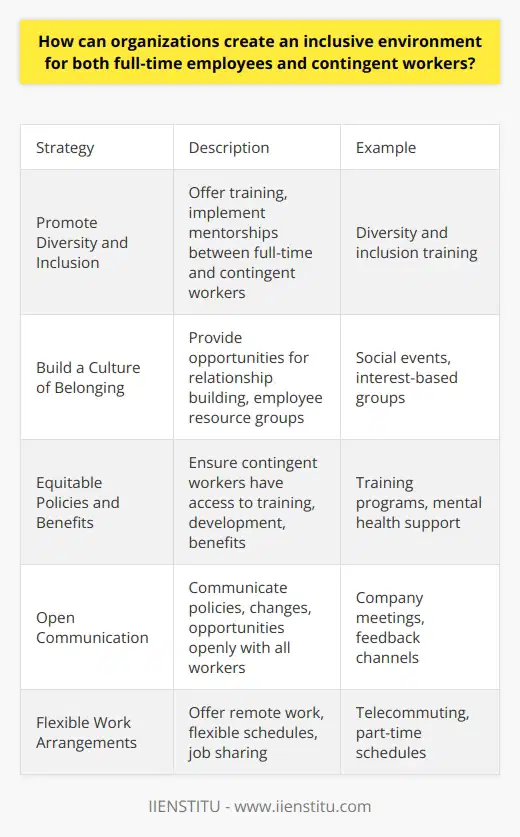
What are some key considerations when developing policies and guidelines that pertain specifically to the contingent workforce?
Inclusivity
Firstly, policymakers should consider inclusivity when designing policies for the contingent workforce. They must ensure fair treatment and avoid discriminating against these workers based on their employment status.
Labor Laws Compliance
Secondly, maintaining compliance with existing labor laws is critical. Policymakers should be aware of regulations pertaining to part-time, temporary, and gig workers, and enshrine applicable rights and protections in their policies.
Suitable Compensation
Thirdly, compensation should be a key consideration. These workers often lack conventional benefits like health insurance or retirement packages, so their pay should reflect this. Addressing fair and suitable compensation helps maintain ethical labor practices.
Job Security Considerations
Policymakers must also consider job security. Although contingency work does not guarantee employment permanence, it's important to mitigate the insecurities associated with such jobs and provide some level of stability.
Flexibility
Flexibility should be another primary focus. Since many contingent workers choose this line of work for its flexibility, creating guidelines that support such needs is crucial.
Training and Development Opportunities
Lastly, the provision of opportunities for training and development should be a consideration. Even though contingent workforce may be temporary in nature, upskilling and enlightening these workers can add value to the organization and augment worker satisfaction.
Remember, every policy involving contingent workforce should enhance their integration into the organization, ensure their well-being and meet their unique needs while safeguarding the interests of the organization. Hence, constant review and timely adjustments are necessary to keep policies relevant and effective.

How can companies ensure smooth collaboration and knowledge transfer between full-time employees and contingent workers?
Structuring Collaborative Framework
For optimal collaboration between full-time employees and contingent workers, companies should first establish a well-structured work framework. This involves setting the right goals, defining roles and responsibilities, and explaining the mutual benefits of collaboration.
Promoting Open Communication
Open lines of communication also facilitate smoother collaboration. Managers should promote a culture that encourages both formal and informal communication between all employees, regardless of their employment status, ensuring that all workers understand and respect their peers' perspectives.
Use of Collaborative Tools
In addition, technology can boost successful collaboration. Utilizing modern collaborative tools - such as shared workspaces, project management software, or instant messaging applications - can streamline communication and foster better knowledge sharing among workers.
Training and Onboarding Processes
Moreover, a company can facilitate smooth knowledge transfer through comprehensive training and onboarding processes for all types of workers. By ensuring that contingent workers receive the same level of training as their full-time counterparts, they can better understand the company culture, work ethics, and goals.
Regular Meetings and Feedback Sessions
Regular meetings and feedback sessions should also be part of the strategy for improving collaboration. These enable both parties to address concerns, share ideas, and celebrate achievements. They also cultivate a sense of togetherness and foster positive working relationships among all workers.
Recognition and Reward Systems
Finally, a recognition and reward system can help stimulate collaboration. Acknowledging the contributions of all workers, regardless of their status, can boost morale and motivate individuals to actively participate in collaborative efforts. By implementing these strategies and maintaining a consistent approach, a company can establish a productive work environment that values the contributions of everyone.
